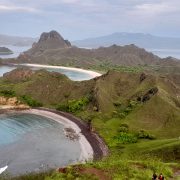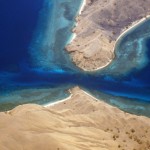Komodo National Park
Natural History, Geology, Biodiversity, Terrestrial, Marine Life, and Climate
Komodo National Park is a wonderful marine tourism destination, with a very special eco-system! It is home to some of the world’s most amazing creatures, from Komodo dragons to flying foxes, from mantas rays to dugongs and thousands of other weird and wonderful marine species.
Natural History
Above water picturesque islands and pink sand beaches will keep you clicking the buttons on your camera. The gorgeous reefs and marine animals in amazing numbers, will make you do the same underwater. The diving in Komodo is world class. Thrilling drift dives, manta ray aggregations, and some of the world’s richest and most beautiful coral reefs.
Geology and Location

Biodiversity

Terrestrial

The most famous land species here is the Komodo Dragon (varanus komodoensis) which is the world’s largest living Monitor lizard and has its place at the top of the food chain. It lives in the wild on five of the islands in the Komodo area.
In addition the larger inhabitants are buffaloes, Rusa deer, horses, boars and monkeys. Further down the scale we find indigenous frogs, snakes, other species of lizards and the endemic Komodo Rat. Over 150 species of birds have also been identified in Komodo National Park including the non-flying Megapode and White-Breasted Sea Eagle.
Marine Life
Below water unique marine ecosystems have formed partly because of the varied topographies to be found here bit also thanks to the varied currents. Although the tidal movement is not very high (0,5-2 meters), in the north of the park it is much greater in the south, creating a tidal incline rushing through the narrow straits between the islands. We can have some very causing strong currents around full and new moon.
These strong currents help dispersing plankton between the two Oceans and many planktons settle in the Komodo Area and thereby causing a very high-biodiversity of corals, fish and invertebrates. These in turn attracts bigger marine life and mammals, some of which also use the channels as natural migratory highways. Our rare and endangered large inhabitants and visitors includes several species of sharks, mantas, mobula rays, turtles, dugongs, dolphins and whales. Rare encounters the Komodo area is in fact part of the Coral Triangle; a terms for the marine area which boasts the highest bio-diversity in the world.
Climate
Komodo is one of the driest areas of Indonesia and on average receives only 14 inches of rainfall per annum, with the majority of this falling between December and March giving the islands of the park an luminous green colour. From Mid-January through to Mid-march we have the higher chance of winds from North-West although this usually only lasts a few days at a time. After some very calm months the winds from the South-East start picking up July through to September. During this time the area gradually gets drier as the dry air mass blowing off the Australian continent leads to a lack of rain and blue skies.
Settlements
There are four settlements in the park. One on Komodo, two on Rinca, One on the island of Papagaran. At 2001 the population was approx 3134 people living in the Their main livelihood is fishing although many are employed by Park Management Authorities and work related to tourism is growing.
The forest is rare deciduous tropical savanna woodland. Deciduous due to the extremes of the wet and dry season rather than temperature. Common species are lontar Palms, Cycads, and Tamarinds. Komodo is one of the driest islands in Indonesia and on average receives 14 inches of Rainfall per Annum with the majority of this falling between December and April.
In addition to the world famous Komodo Dragon (Varanus komodoensis), the larger inhabitants are Buffalos, Rusu deer, monkeys, pigs, and horses. Further down the scale, indigenous frogs, snakes and lizards abound on the island, not to forget the aptly named endemic Komodo Rat. Over 150 species of birds have been identified in Komodo National Park, Wild Rusa Deer can be found on Komodo and Rinca whilst Trekking many of which are migratory and more representative of Australasian than Asiatic species. Distinctive species include Megapodes, Yellow-Crested Cockatoos, Imperial Pigeons, White-breasted Sea Eagles and Maleos.
There are several major islands, Komodo, Rinca, Padar and Gili Motang, and numerous smaller islands through the park.
There are four settlement in the park. One on Komodo, two on Rinca, One on the island of Papagaran. At 2001 the population was approx 3134 people living in the park.
